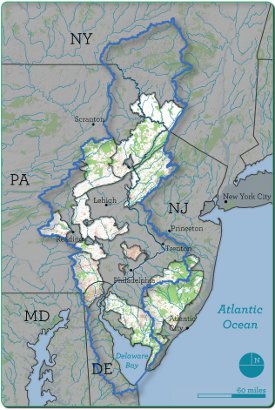
An ambitious effort is underway to protect and restore the Delaware River Basin’s water quality and overall ecological health. Kick-started by a $35 million commitment by the William Penn Foundation, the Delaware River Watershed Initiative (DRWI) is targeting eight “clusters” within the basin for conservation investment.
More than 50 leading nonprofits have joined together, aligning priorities for land protection and restoration projects and assessing water quality impacts using standardized methods. Partners are focusing on reducing agricultural runoff and urban stormwater in areas of lesser water quality, and they are protecting headwaters, forests, and groundwater reserves where water quality is high. Coordination among the many partners will allow the first-ever collection, synthesis, and analysis of data from sites across the basin, generating critical information on what works in river protection and restoration.
About Us


|
The Patrick Center for Environmental Research takes a holistic approach to understanding and improving ecological health by piecing together information on a range of indicators to build a comprehensive picture. The Academy’s DRWI team is representative of that approach and is comprised of scientists with a depth and breadth of knowledge in both physical and biological disciplines, including phycology, fisheries, macroinvertebrate studies, and biogeochemistry. Additionally, watershed and stream modelers provide critical information for understanding how individual monitoring sites relate to each other and to the larger basin.
Meet the Academy’s DRWI team.
|
Where We Work


|
Philadelphia and its metropolitan region lie within the Delaware River Basin. Although it comprises only 0.004 percent of the total continental U.S. land area, more than 15 million people rely on the Delaware River Basin for drinking water. The Delaware River Basin includes large expanses of natural lands that both protect clean water and provide habitat of regional and hemispheric importance. The mainstem is the longest un-dammed river in the United States east of the Mississippi. The DRWI is focusing on eight priority “clusters” within the basin, selected for their potential either to yield the greatest water quality improvements or to maintain currently healthy conditions.
Explore the DRWI’s clusters and monitoring sites.
|
What We Do


|
The Academy’s Patrick Center for Environmental Research is leading the DRWI’s science. Experts are designing and overseeing species and water chemistry monitoring at more than 300 sites and complementing the monitoring with additional research projects. The goal: to assess when and under what circumstances conservation strategies are producing improvements in river health to ensure that the DRWI can be as effective as possible. Successful approaches can ultimately be replicated elsewhere in the Delaware Basin and beyond, extending the reach and impact of the initiative.
Learn more about the Academy’s monitoring.
Learn more about the Academy’s DRWI research projects.
Read about the latest results from the DRWI.
|